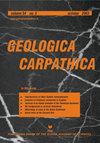kurovice剖面(外喀尔巴阡山脉西部,特提斯山脉北部边缘)远洋层序的侏罗纪/白垩纪边界和高分辨率生物地层学
IF 1.5
4区 地球科学
Q4 GEOSCIENCES, MULTIDISCIPLINARY
引用次数: 16
摘要
在捷克共和国外喀尔巴阡山脉西部的Kurovice采石场,对calpionellid、钙质和非钙质鞭毛藻囊、孢子状体和钙质纳米化石进行了微相和高分辨率的研究,并与古地磁相结合,建立了侏罗纪/白垩纪(J/K)边界的详细地层和古环境解释。Kurovice剖面由异长泥晶灰岩和泥晶灰岩组成。确定的标准微相类型SMF 2、SMF 3和SMF 4表明沉积物沉积于陆架深缘(fz3),后来转变为远端盆地条件和沉积物(fz1)。该层序的地层范围从早梯东世钙质鞭草Malmica带、纳米浮游生物NJT 15带和m21r磁带到早berberasian早晚纪Calpionella带的Calpionella Elliptica亚带、纳米浮游生物NK-1带和m17r磁带。在J/K界线上,高山亚带的基部(对应于NJT - 17b和M - 19n - 2n)小形态高山Calpionella alpina数量增加,而冬季Nannoconus wintereri很少出现。形态包括早期berberasian陆生元素-非钙质甲藻囊肿Achomosphaera neptunii, Prolixosphaeridium sp. A和Tehamadinium evittii。Kurovice的沉积区位于特提斯西北部的边缘。来自北纬地区的冷水和潜在的上升流的影响突出表现在:1)辐射虫和海绵针状体比例高;2)以透明形态为主的calpionellids较为罕见;3)缺乏微颗粒calpionellids - chitinoidides; 4)与特提斯其他遗址相比,纳米化石组合中Nannoconus属、Polycostella属和Conusphaera属的比例较低;5)大西洋地区的Nannoconus compressus较少。本文章由计算机程序翻译,如有差异,请以英文原文为准。
The Jurassic/Cretaceous boundary and high resolution biostratigraphy of the pelagic sequences of the kurovice section (Outer Western Carpathians, the northern Tethyan margin)
Abstract Microfacies and high resolution studies at the Kurovice quarry (Czech Republic, Outer Western Carpathians) on calpionellids, calcareous and non-calcareous dinoflagellate cysts, sporomorphs and calcareous nannofossils, aligned with paleomagnetism, allow construction of a detailed stratigraphy and paleoenvironmental interpretation across the Jurassic/Cretaceous (J/K) boundary. The Kurovice section consists of allodapic and micrite limestones and marlstones. Identified standard microfacies types SMF 2, SMF 3 and SMF 4 indicate that sediments were deposited on a deep shelf margin (FZ 3), with a change, later, into distal basin conditions and sediments (FZ 1). The sequence spans a stratigraphic range from the Early Tithonian calcareous dinoflagellate Malmica Zone, nannoplankton zone NJT 15 and magnetozone M 21r to the late Early Berriasian calpionellid Elliptica Subzone of the Calpionella Zone, nannoplankton NK-1 Zone and M 17r magnetozone. The J/K boundary is marked by a quantitative increase of small forms of Calpionella alpina, the base of the Alpina Subzone (that corresponds to NJT 17b and M 19n.2n) and by the rare occurrence of Nannoconus wintereri. Palynomorphs include Early Berriasian terrestrial elements — non-calcareous dinoflagellate cysts Achomosphaera neptunii, Prolixosphaeridium sp. A and Tehamadinium evittii. The depositional area for Kurovice was situated at the margin of the NW Tethys. The influence of cold waters from northern latitudes and potential upwellings is highlighted by: 1) the high proportion of radiolarians and sponge spicules, 2) rare calpionellids represented mostly by hyaline forms, 3) the absence of microgranular calpionellids — chitinoidellids, 4) the small percentage of the genera Nannoconus, Polycostella and Conusphaera in nannofossil assemblages, as compared to other sites in Tethys, 5) scarce Nannoconus compressus, which has otherwise been mentioned from the Atlantic area.
求助全文
通过发布文献求助,成功后即可免费获取论文全文。
去求助
来源期刊

Geologica Carpathica
地学-地球科学综合
CiteScore
2.40
自引率
23.10%
发文量
26
审稿时长
>12 weeks
期刊介绍:
GEOLOGICA CARPATHICA covers a wide spectrum of geological disciplines including geodynamics, tectonics and structural geology, volcanology, stratigraphy, geochronology and isotopic geology, karstology, geochemistry, mineralogy, petrology, lithology and sedimentology, paleogeography, paleoecology, paleobiology and paleontology, paleomagnetism, magnetostratigraphy and other branches of applied geophysics, economic and environmental geology, experimental and theoretical geoscientific studies. Geologica Carpathica , with its 60 year old tradition, presents high-quality research papers devoted to all aspects not only of the Alpine-Carpathian-Balkanian geoscience but also with adjacent regions originated from the Mediterranean Tethys and its continental foreland. Geologica Carpathica is an Official Journal of the Carpathian-Balkan Geological Association.
 求助内容:
求助内容: 应助结果提醒方式:
应助结果提醒方式:


